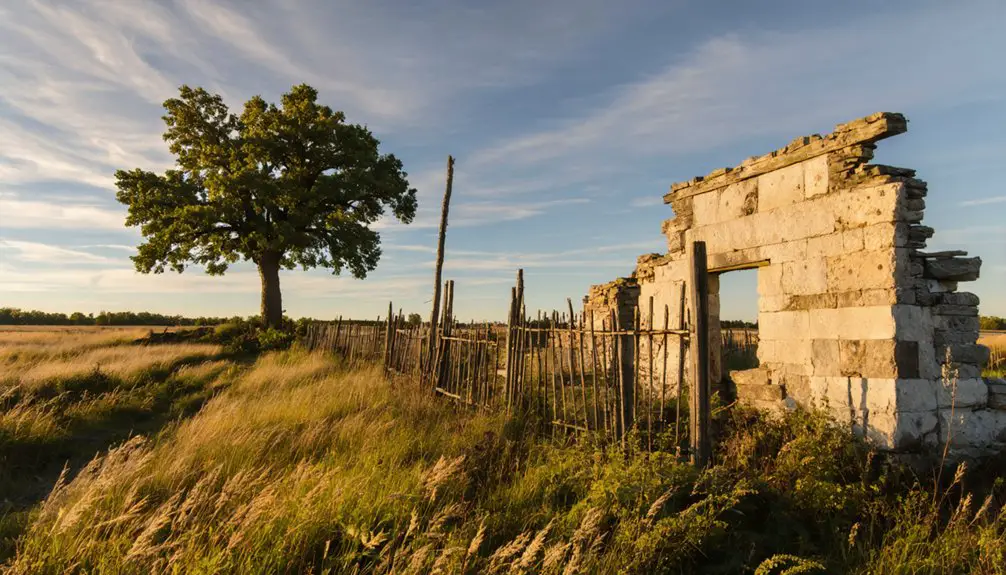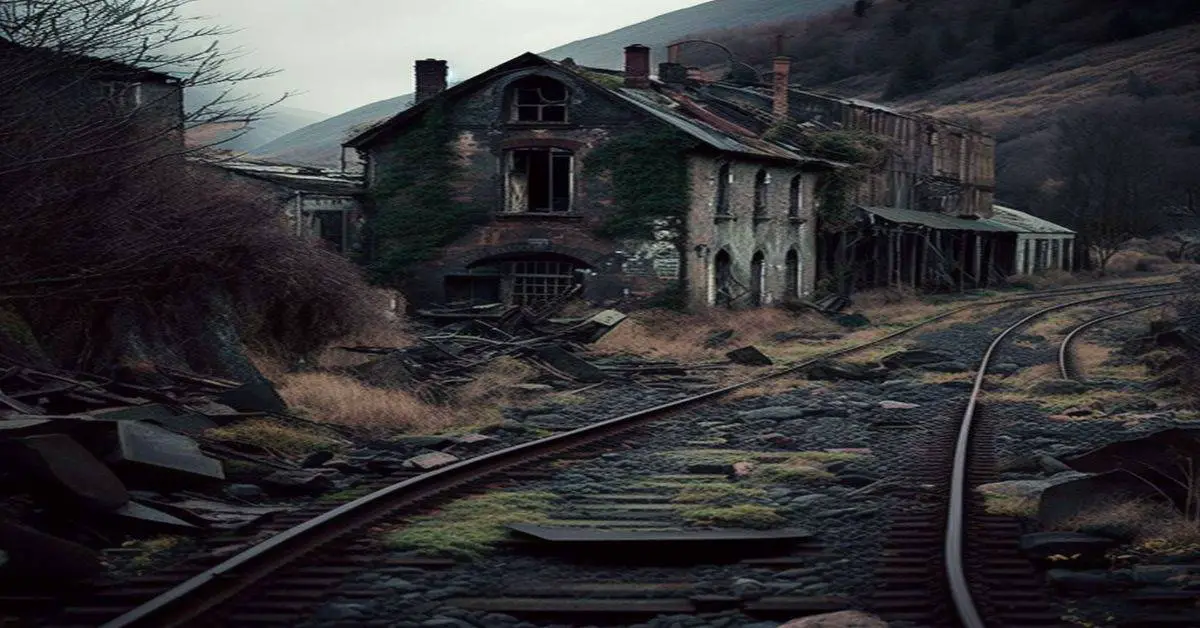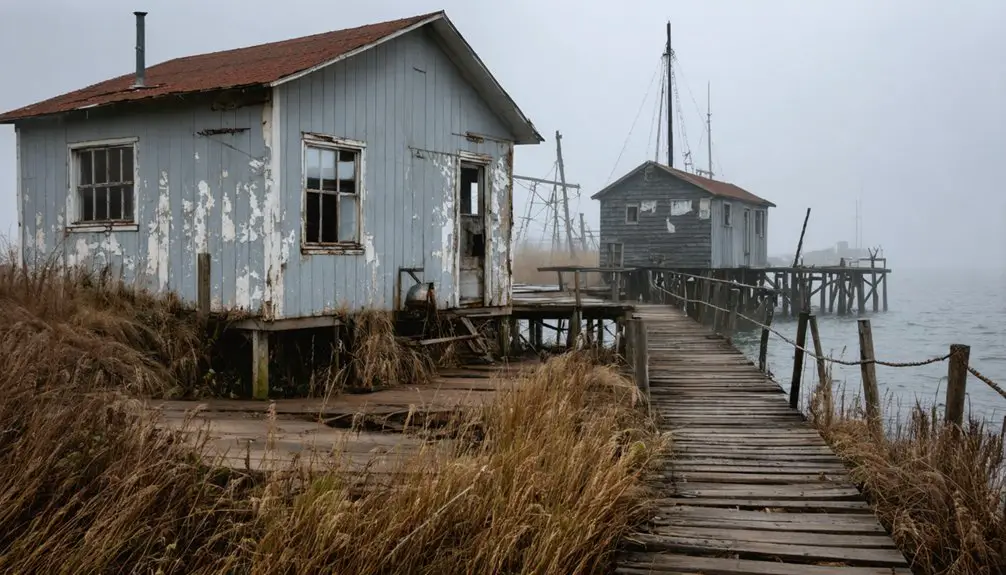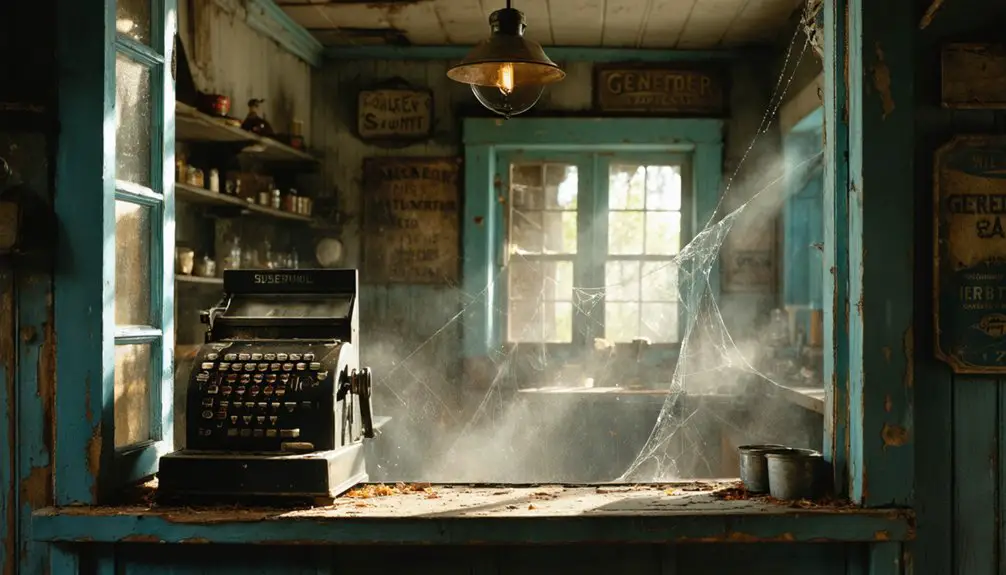You’ll find Pokerville’s remains near Wisconsin’s Cave of the Mounds, where Ebenezer Brigham established this frontier town in 1828. Originally called Blue Mounds West, it earned its unique name from the nightly high-stakes poker games that drew 500 residents during the lead mining boom. The town thrived on gambling, mining, and transportation services until economic challenges, including an 1852 Indian attack and the railroad bypass of 1880, led to its abandonment. The site’s scattered foundations and artifacts tell a fascinating tale of Wisconsin’s Wild West era.
Key Takeaways
- Pokerville was a frontier settlement in Wisconsin known for its gambling culture, attracting 500 residents during its peak in the 1800s.
- The town’s economy relied heavily on lead mining and transportation services along the Lead Mine Trail.
- A devastating Indian attack in 1852 and the railroad bypassing the town in 1880 contributed to its decline.
- The post-Civil War lead market crash eliminated the town’s economic foundation, leading to complete abandonment by early 1900s.
- Three original structures and scattered building foundations remain, with the site now serving as a campground since the 1940s.
Origins and Early Settlement in Dane County
While many Wisconsin settlements emerged in the mid-1800s, Pokerville’s story began shortly after Ebenezer Brigham established himself near the Cave of the Mounds in 1828. As one of Dane County’s earliest communities, you’ll find that settlement patterns were heavily influenced by the area’s natural landmarks, which provided crucial resources and shelter for frontier life.
The cultural influences of frontier living quickly took hold, as settlers sought opportunities in this untamed territory. You’ll discover that Pokerville’s strategic location west of Blue Mounds made it an attractive spot for early pioneers. The town, originally called Blue Mounds West, developed a reputation for its rough-and-tumble atmosphere. The town became an important stop on the Lead Mine Trail that connected New Diggings to Milwaukee.
The settlement’s proximity to essential resources like water and timber supported its growth, though this development wasn’t without challenges. The Black Hawk War of 1832 disrupted early settlement efforts, forcing residents to seek safety before returning to rebuild their community.
The Story Behind the Pokerville Name
You’ll find that Pokerville earned its distinctive name from the rowdy crowds who gathered nightly to play poker, drink, and occasionally brawl in the settlement’s early days.
The gambling culture, which drew an estimated 500 residents to the area, reflected the broader trend of card games serving as social focal points in 19th-century Wisconsin frontier towns. Like many places across the region, the landscape featured dramatic red sandstone bluffs that dominated the surrounding terrain.
While other Wisconsin settlements typically derived their names from geographical features or founders, Pokerville’s name captured the wild spirit of its inhabitants and their favorite pastime. After a brutal Indian attack in 1852, the settlement relocated to a more secure location at the foot of the Blue Mounds.
Wild West Gambling Culture
Three key elements shaped the gambling culture that gave Pokerville its name: high-stakes card games, professional gamblers, and the significant role of gaming halls as economic centers.
You’d find these establishments bustling with activity, where frontier competitions drew diverse crowds of miners, cowboys, and merchants alike. The introduction of Faro and Monte transformed these gambling halls into exciting venues where fortunes could be made or lost in a single night. Professional gamblers ran their operations like legitimate businesses, renting tables and maintaining strict gambling etiquette to guarantee fair play.
The gaming halls weren’t just about cards and dice – they served as essential social hubs where news spread, business deals took shape, and community bonds formed. These gambling establishments often became the largest buildings in newly established settlements.
In towns like Pokerville, these venues helped transform raw settlements into structured communities, with gambling revenue often funding local development and important services. The presence of renowned gamblers and gunfighters added an extra layer of security and attraction to these establishments.
Poker’s Role in Identity
Unlike most Wisconsin settlements named after geographical features or prominent settlers, Pokerville earned its distinctive moniker from the raucous poker gatherings that defined its nightlife.
When you examine the poker psychology that shaped this community of 500 residents, you’ll find that gambling wasn’t just a vice – it was the heartbeat of their social identity.
The nightly card games created a unique cultural fingerprint, setting Pokerville apart from neighboring towns like Platteville and Mount Horeb. This was particularly evident in 1827 when Platteville was still known as Platte River before its later name changes. The area eventually became part of Blue Mounds Village when the Chicago and North Western Railway arrived in 1881.
While questions of gambling ethics might’ve troubled other communities, Pokerville embraced its reputation. The town’s name became a folk marker, reflecting the accepted normalcy of poker as a binding social force.
Even today, as a ghost town, Pokerville’s identity remains inextricably linked to the card-playing culture that gave it its name.
Life and Culture in a Frontier Gambling Town
Life in Pokerville revolved around two central activities – gambling and drinking – which shaped the frontier town’s vibrant yet volatile culture. You’d find yourself in a community of about 500 people, mostly men, where poker games stretched late into the night and taverns buzzed with activity.
Despite frontier challenges like isolation and limited services, the town’s social dynamics thrived around gaming tables where news, politics, and local gossip flowed freely. Today, historical records and documentation about the settlement can be accessed through the Wisconsin Historical Society.
You wouldn’t find many formal institutions here – churches and schools were scarce. Instead, you’d navigate a rough-and-tumble atmosphere where brawls erupted regularly and gambling disputes could turn violent.
The town’s character balanced precariously between a close-knit frontier community and a wild outpost where fortunes could be won or lost over a single hand of cards.
Peak Population and Community Development
While exact population figures remain elusive in historical records, Pokerville’s peak development occurred prior to 1880, when you’d find a bustling frontier community originally known as Blue Mounds West.
The population dynamics reflected a vibrant social scene, with enough residents and visitors to support multiple gambling establishments and liquor venues. Similar to how beaver dams support wildlife, the town’s gathering spots fostered a diverse mix of travelers, traders, and local residents.
The community structure centered around three key elements:
- Active commerce driven by gambling and entertainment
- Organic development focused on social gathering spaces
- Basic frontier amenities typical of the era
You’d witness a town that thrived on its reputation as a gambling destination, though it lacked the industrial infrastructure found in other Wisconsin settlements.
This distinctive character shaped Pokerville’s development until the railroad’s arrival east of town triggered its eventual decline.
Impact of the Blackhawk War of 1832
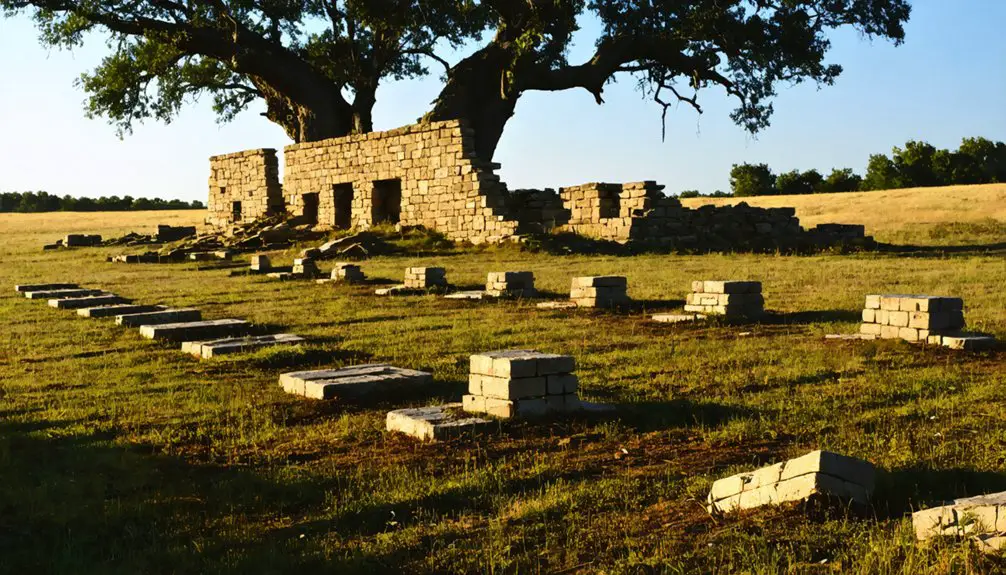
As the Black Hawk War swept through Wisconsin in 1832, you’d find Pokerville’s region transformed by intense military engagements and widespread displacement of Native peoples.
During Black Hawk’s Resistance, militia forces under Henry Dodge and James Henry pursued Native warriors through the area, leading to devastating battles like Wisconsin Heights where 70 Sauk and Fox warriors died.
Militia commanders Dodge and Henry relentlessly tracked Native warriors, culminating in the deadly Wisconsin Heights battle that claimed 70 lives.
You’d witness Native displacement accelerate as the British Band retreated through local swamps and waterways, desperately trying to escape to the Mississippi River.
The conflict’s aftermath reshaped the region’s demographics, pushing Ho-Chunk people from their lands south of the Wisconsin River. This forced removal opened territories around Pokerville for American settlement, though at a devastating cost to Native communities’ social structures and sovereignty.
Daily Life and Social Activities
If you’d visited Pokerville during its heyday, you would’ve found its bustling social scene centered around nightly card games that drew crowds to the town’s gambling houses.
These spirited gatherings, which often stretched into the early morning hours, served as the community’s primary form of entertainment and social bonding for its roughly 500 residents.
The combination of poker, spirits, and social intermingling created a lively, if sometimes volatile, atmosphere that defined the settlement’s character and attracted visitors from surrounding areas.
Evening Card Games
The evening card games of Pokerville formed the beating heart of this Wisconsin settlement’s social life, so much that they inspired the town’s very name. You’d find yourself drawn to the lively atmosphere of these nightly gatherings, where gambling folklore and card game strategies merged with the clinking of glasses and spirited conversation.
- Your chances of witnessing a heated game increased after dusk, when players gathered to test their luck and skill at poker.
- You’d encounter a diverse crowd of locals and travelers, all seeking the thrill of the game and social connection.
- While you might’ve seen occasional fights break out over high-stakes hands, these gatherings strengthened community bonds.
These nightly games became more than entertainment – they defined Pokerville’s identity and ultimately contributed to its historical legacy as a vibrant frontier settlement.
Daily Social Gatherings
Beyond the evening poker tables, Pokerville buzzed with social activity throughout daylight hours, centered around its taverns and general stores. You’d find locals swapping stories over drinks, trading news, and building community bonding through casual encounters.
Workers would gather after their daily tasks, strengthening relationships through shared experiences and collaborative projects.
Tavern gatherings dominated the social landscape, where about 500 residents could enjoy drinks while discussing local affairs. The town’s multiple drinking establishments fostered a lively, though often rowdy, atmosphere.
You’d witness impromptu meetings in streets and doorways, while merchants and tradesmen formed connections through their daily business dealings.
Even the Cave of the Mounds served as a distinctive meeting spot where townspeople would congregate for special occasions and community celebrations.
Economic Activities and Local Industries
Situated along the bustling Lead Mine Trail in the 1830s, Pokerville’s economy thrived primarily on lead mining activities and related transportation services. You’d find heavily loaded wagons regularly passing through town, creating demand for mining services and lead transportation infrastructure that shaped the community’s growth.
The town’s economic foundation rested on three main pillars:
- Mining and transport services: blacksmith shops, harness makers, and wagon repair facilities
- Hospitality and trade: two inns, general stores, and entertainment venues catering to miners and travelers
- Agricultural support: farming operations that provided essential food and supplies to the mining community
Beyond these core industries, you’d discover a thriving network of businesses including a local doctor’s practice and various craftsmen, all contributing to Pokerville’s vibrant economic landscape.
The Gradual Decline and Abandonment
Despite its early economic importance, Pokerville faced mounting challenges that would ultimately lead to its complete abandonment. The town’s decline accelerated after a devastating Indian attack in 1852 forced survivors to relocate buildings to safer ground.
You’ll find that warfare consequences and ongoing regional conflicts created an atmosphere of insecurity that discouraged settlement.
The transportation impact dealt another severe blow when the railroad bypassed Pokerville in 1880, isolating the community from crucial trade routes. This isolation, combined with the post-Civil War lead market crash, eliminated the town’s economic foundation.
Without mining jobs or railway connections, residents had no reason to stay. Social institutions crumbled as families moved away, and by the early 20th century, Pokerville had vanished entirely, leaving no physical traces of its existence.
Physical Remains and Historical Sites
When you visit Pokerville today, you’ll find at least three original structures still standing among scattered building foundations that hint at the town’s former layout.
The site’s transformation into a campground in the 1940s has preserved key archaeological features, including remnants of the settlement’s mining-era architecture and an abandoned lead mine.
You can trace the town’s historical footprint through these physical remains, which persist despite minimal preservation efforts and the gradual encroachment of Wisconsin’s natural woodland.
Ruins and Building Foundations
Among the scattered remnants of Pokerville’s past, you’ll find building foundations and cellar holes that hint at the town’s former liveliness.
While building preservation efforts are limited due to extensive deterioration, archaeological methods like ground-penetrating radar help reveal the settlement’s original layout.
Smart and Cromwell’s general store foundation remains one of the most significant traces of the town’s commercial heart.
- You can trace relocated structures from the post-1852 attack through their distinctive foundation patterns.
- The original post office and stagecoach inn locations offer key insights into the town’s infrastructure.
- Stone boundary walls and farmstead foundations mark the outer edges of what was once a thriving community.
Natural reclamation and weathering continue to challenge site visibility, with many ruins now hidden beneath vegetation and eroded soil.
Archaeological Discovery Sites
Archaeological excavations across Pokerville’s ghost town have revealed a rich tapestry of physical artifacts and historical sites that tell the settlement’s story.
You’ll find compelling evidence of the town’s archaeological significance along the Lead Mine Trail, where mining tools and trade items showcase its industrial heritage. Gaming tokens discovered near trading posts confirm the gambling culture that inspired the town’s name.
The historical context of Pokerville’s decline is preserved in burial sites and memorial markers commemorating the 1852 Indian attack.
At the Pokerville Ironworks site, you can explore foundation remains, slag heaps, and metallurgical waste that document early manufacturing processes.
Archaeological studies have mapped the settlement’s layout through preserved wagon ruts, footpaths, and artifact distribution patterns along historical trade routes.
Preserved Town Layout Features
Today’s visitors to Pokerville can still find three original buildings standing amid the ghost town‘s remnants, including the historic fandango house that once hosted the settlement’s social gatherings.
While nature has reclaimed much of the original town grid, you’ll discover traces of the compact settlement layout through remaining foundations and building footprints.
Key preserved features you can explore:
- A cluster of abandoned residential and commercial structures arranged around the historic mine site
- The fandango house, a rare surviving social landmark that reflects the town’s vibrant past
- Building foundations and partial roadbeds that outline the original street pattern, revealing how this mining community was organized
The site’s untouched state offers a raw glimpse into Wisconsin’s early mining history, though most cultural landmarks now exist only as ruins.
Preserving Pokerville’s Frontier Legacy
Despite limited physical remains, Pokerville’s frontier legacy endures through dedicated preservation efforts by local historical societies and community organizations.
You’ll find the town’s colorful history preserved through various heritage preservation initiatives, including archived documents, oral histories, and educational programs that highlight early Wisconsin settlement.
Community engagement efforts bring Pokerville’s past to life through regional history tours and local heritage events showcasing 19th-century rural customs.
While the original structures may be gone, you can explore the town’s fascinating story through museum exhibits and digital archives.
Historical societies continue documenting Pokerville’s unique role as Dane County’s earliest settlement, its involvement in the Blackhawk War, and its reputation for gambling and revelry.
These preservation efforts guarantee that future generations can connect with this important piece of Wisconsin’s frontier history.
Frequently Asked Questions
What Happened to the Original Buildings and Structures of Pokerville?
You’ll find that while some original structures were moved after an 1852 Indian attack, most buildings weren’t preserved. Without historical preservation efforts, they’ve vanished through abandonment, decay, or destruction.
Were There Any Famous People or Notable Outlaws From Pokerville?
You won’t find any famous residents or notorious figures definitively linked to this frontier town. While it had a reputation for rowdiness, historical records don’t identify any outlaws or celebrities among its people.
What Was the Average Gambling Loss or Win in Pokerville’s Saloons?
You’d find Lady Luck was rather fickle in frontier saloon culture, with most folks losing $1-$5 nightly. Though gambling statistics aren’t exact, the house usually kept its edge over patrons.
Did Pokerville Have a Local Law Enforcement System or Sheriff?
You won’t find records of formal law enforcement or sheriff duties in this town. Historical evidence suggests residents handled disputes informally, with minimal outside intervention from county authorities when needed.
Were There Any Documented Murders or Major Crimes in Pokerville?
Like shadows in an empty room, you won’t find clear murder mysteries or crime reports. Historical records don’t document any murders in Pokerville, though gambling fights and social disorder were common.
References
- https://upnorthnewswi.com/2024/02/21/the-fascinating-stories-behind-7-wisconsin-ghost-towns/
- http://sites.rootsweb.com/~witttp/ghosttowns/pokerville/pokervillegt.htm
- https://www.pokervilleironworks.com/history.php
- https://www.wisconsinhistory.org/Records/Newspaper/BA12622
- https://www.ghosttowns.com/states/wi/pokerville.html
- https://www.wisconsinhistory.org/Records/Article/CS3663
- https://www.platteville.org/community/page/history
- https://www.mthorebhistory.org/community-histories.html
- https://www.jonathanfesmire.com/2024/04/06/
- https://worldfamousgunfighters.weebly.com/gambling.html
